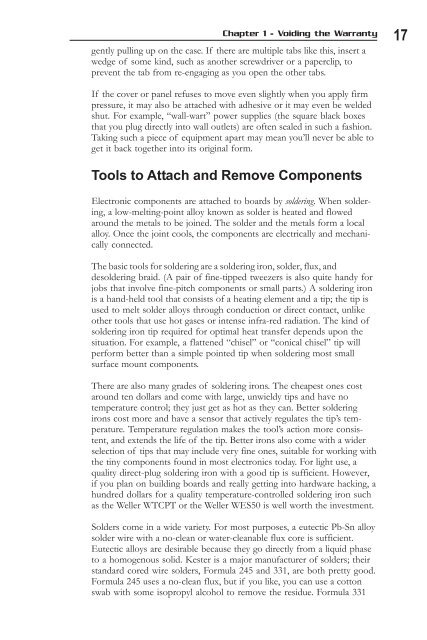Hacking the Xbox
Hacking the Xbox
Hacking the Xbox
You also want an ePaper? Increase the reach of your titles
YUMPU automatically turns print PDFs into web optimized ePapers that Google loves.
Chapter 1 - Voiding <strong>the</strong> Warranty 17<br />
gently pulling up on <strong>the</strong> case. If <strong>the</strong>re are multiple tabs like this, insert a<br />
wedge of some kind, such as ano<strong>the</strong>r screwdriver or a paperclip, to<br />
prevent <strong>the</strong> tab from re-engaging as you open <strong>the</strong> o<strong>the</strong>r tabs.<br />
If <strong>the</strong> cover or panel refuses to move even slightly when you apply firm<br />
pressure, it may also be attached with adhesive or it may even be welded<br />
shut. For example, “wall-wart” power supplies (<strong>the</strong> square black boxes<br />
that you plug directly into wall outlets) are often sealed in such a fashion.<br />
Taking such a piece of equipment apart may mean you’ll never be able to<br />
get it back toge<strong>the</strong>r into its original form.<br />
Tools to Attach and Remove Components<br />
Electronic components are attached to boards by soldering. When soldering,<br />
a low-melting-point alloy known as solder is heated and flowed<br />
around <strong>the</strong> metals to be joined. The solder and <strong>the</strong> metals form a local<br />
alloy. Once <strong>the</strong> joint cools, <strong>the</strong> components are electrically and mechanically<br />
connected.<br />
The basic tools for soldering are a soldering iron, solder, flux, and<br />
desoldering braid. (A pair of fine-tipped tweezers is also quite handy for<br />
jobs that involve fine-pitch components or small parts.) A soldering iron<br />
is a hand-held tool that consists of a heating element and a tip; <strong>the</strong> tip is<br />
used to melt solder alloys through conduction or direct contact, unlike<br />
o<strong>the</strong>r tools that use hot gases or intense infra-red radiation. The kind of<br />
soldering iron tip required for optimal heat transfer depends upon <strong>the</strong><br />
situation. For example, a flattened “chisel” or “conical chisel” tip will<br />
perform better than a simple pointed tip when soldering most small<br />
surface mount components.<br />
There are also many grades of soldering irons. The cheapest ones cost<br />
around ten dollars and come with large, unwieldy tips and have no<br />
temperature control; <strong>the</strong>y just get as hot as <strong>the</strong>y can. Better soldering<br />
irons cost more and have a sensor that actively regulates <strong>the</strong> tip’s temperature.<br />
Temperature regulation makes <strong>the</strong> tool’s action more consistent,<br />
and extends <strong>the</strong> life of <strong>the</strong> tip. Better irons also come with a wider<br />
selection of tips that may include very fine ones, suitable for working with<br />
<strong>the</strong> tiny components found in most electronics today. For light use, a<br />
quality direct-plug soldering iron with a good tip is sufficient. However,<br />
if you plan on building boards and really getting into hardware hacking, a<br />
hundred dollars for a quality temperature-controlled soldering iron such<br />
as <strong>the</strong> Weller WTCPT or <strong>the</strong> Weller WES50 is well worth <strong>the</strong> investment.<br />
Solders come in a wide variety. For most purposes, a eutectic Pb-Sn alloy<br />
solder wire with a no-clean or water-cleanable flux core is sufficient.<br />
Eutectic alloys are desirable because <strong>the</strong>y go directly from a liquid phase<br />
to a homogenous solid. Kester is a major manufacturer of solders; <strong>the</strong>ir<br />
standard cored wire solders, Formula 245 and 331, are both pretty good.<br />
Formula 245 uses a no-clean flux, but if you like, you can use a cotton<br />
swab with some isopropyl alcohol to remove <strong>the</strong> residue. Formula 331


